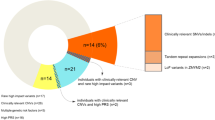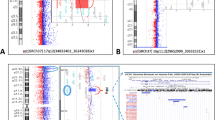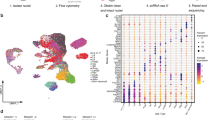Abstract
MECP2 mutations are responsible for two different phenotypes in females, classical Rett syndrome and the milder Zappella variant (Z-RTT). We investigated whether copy number variants (CNVs) may modulate the phenotype by comparison of array-CGH data from two discordant pairs of sisters and four additional discordant pairs of unrelated girls matched by mutation type. We also searched for potential MeCP2 targets within CNVs by chromatin immunopreceipitation microarray (ChIP–chip) analysis. We did not identify one major common gene/region, suggesting that modifiers may be complex and variable between cases. However, we detected CNVs correlating with disease severity that contain candidate modifiers. CROCC (1p36.13) is a potential MeCP2 target, in which a duplication in a Z-RTT and a deletion in a classic patient were observed. CROCC encodes a structural component of ciliary motility that is required for correct brain development. CFHR1 and CFHR3, on 1q31.3, may be involved in the regulation of complement during synapse elimination, and were found to be deleted in a Z-RTT but duplicated in two classic patients. The duplication of 10q11.22, present in two Z-RTT patients, includes GPRIN2, a regulator of neurite outgrowth and PPYR1, involved in energy homeostasis. Functional analyses are necessary to confirm candidates and to define targets for future therapies.
Similar content being viewed by others
Log in or create a free account to read this content
Gain free access to this article, as well as selected content from this journal and more on nature.com
or
Accession codes
References
Trevathan, E. & Moser, H. W. Diagnostic criteria for Rett syndrome. Ann. Neurol. 23, 425–428 (1988).
Neul, J., Kaufmann, W., Glaze, D., Christodoulou, J., Clarke, A., Bahi-Buisson, N. et al. Rett syndrome: revised diagnostic criteria and nomenclature. Annals of Neurology 68, 944–950 (2010).
Mencarelli, M. A., Spanhol-Rosseto, A., Artuso, R., Rondinella, D., De Filippis, R., Bahi-Buisson, N. et al. Novel FOXG1 mutations associated with the congenital variant of Rett syndrome. J. Med. Genet. 47, 49–53 (2010).
Zappella, M. The Rett girls with preserved speech. Brain Dev. 14, 98–101 (1992).
Renieri, A., Mari, F., Mencarelli, M. A., Scala, E., Ariani, F., Longo, I. et al. Diagnostic criteria for the Zappella variant of Rett syndrome (the preserved speech variant). Brain Dev. 31, 208–216 (2009).
Weaving, L., Christodoulou, J., Williamson, S., Friend, K., McKenzie, O., Archer, H. et al. Mutations of CDKL5 cause a severe neurodevelopmental disorder with infantile spasms and mental retardation. Am. J. Hum. Genet. 75, 1079–1093 (2004).
Scala, E., Ariani, F., Mari, F., Caselli, R., Pescucci, C., Longo, I. et al. CDKL5/STK9 is mutated in Rett syndrome variant with infantile spasms. J. Med. Genet. 42, 103–107 (2005).
Ariani, F., Hayek, G., Rondinella, D., Artuso, R., Mencarelli, M. A., Spanhol-Rosseto, A. et al. FOXG1 is responsible for the congenital variant of Rett syndrome. Am. J. Hum. Genet. 83, 89–93 (2008).
Zappella, M., Meloni, I., Longo, I., Hayek, G. & Renieri, A. Preserved speech variants of the Rett Syndrome: molecular and clinical analysis. Am. J. Med. Genet. 104, 14–22 (2001).
Hardwick, S. A., Reuter, K., Williamson, S. L., Vasudevan, V., Donald, J., Slater, K. et al. Delineation of large deletions of the MECP2 gene in Rett syndrome patients, including a familial case with a male proband. Eur. J. Hum. Genet. 15, 1218–1229 (2007).
Amir, R. E., Van den Veyver, I. B., Schultz, R., Malicki, D. M., Tran, C. Q., Dahle, E. J. et al. Influence of mutation type and X chromosome inactivation on Rett syndrome phenotypes. Ann. Neurol. 47, 670–679 (2000).
Scala, E., Longo, I., Ottimo, F., Speciale, C., Sampieri, K., Katzaki, E. et al. MECP2 deletions and genotype-phenotype correlation in Rett syndrome. Am. J. Med. Genet. A 143, 2775–2784 (2007).
Evans, J. C., Archer, H. L., Whatley, S. D. & Clarke, A. Germline mosaicism for a MECP2 mutation in a man with two Rett daughters. Clin. Genet. 70, 336–338 (2006).
Mari, F., Azimonti, S., Bertani, I., Bolognese, F., Colombo, E., Caselli, R. et al. CDKL5 belongs to the same molecular pathway of MeCP2 and it is responsible for the early-onset seizure variant of Rett syndrome. Hum. Mol. Genet. 14, 1935–1946 (2005).
Archer, H., Evans, J., Leonard, H., Colvin, L., Ravine, D., Christodoulou, J. et al. Correlation between clinical severity in patients with Rett syndrome with a p.R168X or p.T158M MECP2 mutation, and the direction and degree of skewing of X-chromosome inactivation. J. Med. Genet. 44, 148–152 (2007).
Zoghbi, H. Y., Percy, A. K., Schultz, R. J. & Fill, C. Patterns of X chromosome inactivation in the Rett syndrome. Brain Dev. 12, 131–135 (1990).
Sharp, A., Robinson, D. & Jacobs, P. Age- and tissue-specific variation of X chromosome inactivation ratios in normal women. Hum. Genet. 107, 343–349 (2000).
Anvret, M. & Wahlstrom, J. Rett syndrome: random X chromosome inactivation. Clin. Genet. 45, 274–275 (1994).
LaSalle, J. M., Goldstine, J., Balmer, D. & Greco, C. M. Quantitative localization of heterogeneous methyl-CpG-binding protein 2 (MeCP2) expression phenotypes in normal and Rett syndrome brain by laser scanning cytometry. Hum. Mol. Genet. 10, 1729–1740 (2001).
Shahbazian, M. D., Sun, Y. & Zoghbi, H. Y. Balanced X chromosome inactivation patterns in the Rett syndrome brain. Am. J. Med. Genet. 111, 164–168 (2002).
Gibson, J. H., Williamson, S. L., Arbuckle, S. & Christodoulou, J. X chromosome inactivation patterns in brain in Rett syndrome: implications for the disease phenotype. Brain Dev. 27, 266–270 (2005).
Nag, N., Mellott, T. J. & Berger-Sweeney, J. E. Effects of postnatal dietary choline supplementation on motor regional brain volume and growth factor expression in a mouse model of Rett syndrome. Brain. Res. 1237, 101–109 (2008).
Lonetti, G., Angelucci, A., Morando, L., Boggio, E. M., Giustetto, M. & Pizzorusso, T. Early environmental enrichment moderates the behavioral and synaptic phenotype of MeCP2 null mice. Biol. Psychiatry. 67, 657–665.
Aitman, T. J., Dong, R., Vyse, T. J., Norsworthy, P. J., Johnson, M. D., Smith, J. et al. Copy number polymorphism in Fcgr3 predisposes to glomerulonephritis in rats and humans. Nature 439, 851–855 (2006).
Mamtani, M., Rovin, B., Brey, R., Camargo, J. F., Kulkarni, H., Herrera, M. et al. CCL3L1 gene-containing segmental duplications and polymorphisms in CCR5 affect risk of systemic lupus erythaematosus. Ann. Rheum. Dis. 67, 1076–1083 (2008).
Hollox, E. J. Copy number variation of beta-defensins and relevance to disease. Cytogenet. Genome. Res. 123, 148–155 (2008).
Fellermann, K., Stange, D. E., Schaeffeler, E., Schmalzl, H., Wehkamp, J., Bevins, C. L. et al. A chromosome 8 gene-cluster polymorphism with low human beta-defensin 2 gene copy number predisposes to Crohn disease of the colon. Am. J. Hum. Genet. 79, 439–448 (2006).
Singleton, A. B., Farrer, M., Johnson, J., Singleton, A., Hague, S., Kachergus, J. et al. alpha-Synuclein locus triplication causes Parkinson's disease. Science 302, 841 (2003).
Ibanez, P., Bonnet, A. M., Debarges, B., Lohmann, E., Tison, F., Pollak, P. et al. Causal relation between alpha-synuclein gene duplication and familial Parkinson's disease. Lancet 364, 1169–1171 (2004).
Stefansson, H., Rujescu, D., Cichon, S., Pietilainen, O. P., Ingason, A., Steinberg, S. et al. Large recurrent microdeletions associated with schizophrenia. Nature 455, 232–236 (2008).
Diskin, S. J., Hou, C., Glessner, J. T., Attiyeh, E. F., Laudenslager, M., Bosse, K. et al. Copy number variation at 1q21.1 associated with neuroblastoma. Nature 459, 987–991 (2009).
Frank, B., Hemminki, K., Meindl, A., Wappenschmidt, B., Sutter, C., Kiechle, M. et al. BRIP1 (BACH1) variants and familial breast cancer risk: a case-control study. BMC Cancer 7, 83 (2007).
Karypidis, A. H., Olsson, M., Andersson, S. O., Rane, A. & Ekstrom, L. Deletion polymorphism of the UGT2B17 gene is associated with increased risk for prostate cancer and correlated to gene expression in the prostate. Pharmacogenomics J. 8, 147–151 (2008).
Iafrate, A. J., Feuk, L., Rivera, M. N., Listewnik, M. L., Donahoe, P. K., Qi, Y. et al. Detection of large-scale variation in the human genome. Nat. Genet. 36, 949–951 (2004).
Redon, R., Ishikawa, S., Fitch, K. R., Feuk, L., Perry, G. H., Andrews, T. D. et al. Global variation in copy number in the human genome. Nature 444, 444–454 (2006).
Sampieri, K., Meloni, I., Scala, E., Ariani, F., Caselli, R., Pescucci, C. et al. Italian Rett database and biobank. Hum. Mutat. 28, 329–335 (2007).
Pegoraro, E., Schimke, R. N., Arahata, K., Hayashi, Y., Stern, H., Marks, H. et al. Detection of new paternal dystrophin gene mutations in isolated cases of dystrophinopathy in females. Am. J. Hum. Genet. 54, 989–1003 (1994).
Hagberg, B., Hanefeld, F., Percy, A. & Skjeldal, O. An update on clinically applicable diagnostic criteria in Rett syndrome. Comments to Rett syndrome clinical criteria consensus panel satellite to European paediatric neurology society meeting, Baden Baden, Germany, 11 September 2001. Eur. J. Paediatr. Neurol. 6, 293–297 (2002).
Sampieri, K., Amenduni, M., Papa, F. T., Katzaki, E., Mencarelli, M. A., Marozza, A. et al. Array comparative genomic hybridization in retinoma and retinoblastoma tissues. Cancer Sci. 100, 465–471 (2009).
Yasui, D. H., Peddada, S., Bieda, M. C., Vallero, R. O., Hogart, A., Nagarajan, R. P. et al. Integrated epigenomic analyses of neuronal MeCP2 reveal a role for long-range interaction with active genes. Proc. Natl. Acad. Sci. USA 104, 19416–19421 (2007).
Yang, J., Liu, X., Yue, G., Adamian, M., Bulgakov, O. & Li, T. Rootletin, a novel coiled-coil protein, is a structural component of the ciliary rootlet. J. Cell. Biol. 159, 431–440 (2002).
Lee, J. H. & Gleeson, J. G. The role of primary cilia in neuronal function. Neurobiol. Dis. 38, 167–172.
McClintock, T. S., Glasser, C. E., Bose, S. C. & Bergman, D. A. Tissue expression patterns identify mouse cilia genes. Physiol. Genomics. 32, 198–206 (2008).
Badano, J. L., Mitsuma, N., Beales, P. L. & Katsanis, N. The ciliopathies: an emerging class of human genetic disorders. Annu. Rev. Genomics. Hum. Genet. 7, 125–148 (2006).
Han, Y. G. & Alvarez-Buylla, A. Role of primary cilia in brain development and cancer. Curr. Opin. Neurobiol. 20, 58–67.
Male, D. A., Ormsby, R. J., Ranganathan, S., Giannakis, E. & Gordon, D. L. Complement factor H: sequence analysis of 221 kb of human genomic DNA containing the entire fH, fHR-1 and fHR-3 genes. Mol. Immunol. 37, 41–52 (2000).
Hughes, A. E., Orr, N., Esfandiary, H., Diaz-Torres, M., Goodship, T. & Chakravarthy, U. A common CFH haplotype, with deletion of CFHR1 and CFHR3, is associated with lower risk of age-related macular degeneration. Nat. Genet. 38, 1173–1177 (2006).
Raychaudhuri, S., Ripke, S., Li, M., Neale, B. M., Fagerness, J., Reynolds, R. et al. Associations of CFHR1-CFHR3 deletion and a CFH SNP to age-related macular degeneration are not independent. Nat. Genet. 42, 553–555. author reply 555-556.
Jozsi, M., Licht, C., Strobel, S., Zipfel, S. L., Richter, H., Heinen, S. et al. Factor H autoantibodies in atypical hemolytic uremic syndrome correlate with CFHR1/CFHR3 deficiency. Blood 111, 1512–1514 (2008).
Derecki, N. C., Privman, E. & Kipnis, J. Rett syndrome and other autism spectrum disorders—Brain diseases of immune malfunction? Mol. Psychiatry 15, 355–363.
Stevens, B., Allen, N. J., Vazquez, L. E., Howell, G. R., Christopherson, K. S., Nouri, N. et al. The classical complement cascade mediates CNS synapse elimination. Cell 131, 1164–1178 (2007).
Armstrong, D. D. Neuropathology of Rett syndrome. J. Child Neurol. 20, 747–753 (2005).
Iida, N. & Kozasa, T. Identification and biochemical analysis of GRIN1 and GRIN2. Methods Enzymol. 390, 475–483 (2004).
Kamiji, M. M. & Inui, A. Neuropeptide y receptor selective ligands in the treatment of obesity. Endocr. Rev. 28, 664–684 (2007).
Sainsbury, A., Schwarzer, C., Couzens, M., Fetissov, S., Furtinger, S., Jenkins, A. et al. Important role of hypothalamic Y2 receptors in body weight regulation revealed in conditional knockout mice. Proc. Natl Acad. Sci. USA 99, 8938–8943 (2002).
Sha, B. Y., Yang, T. L., Zhao, L. J., Chen, X. D., Guo, Y., Chen, Y. et al. Genome-wide association study suggested copy number variation may be associated with body mass index in the Chinese population. J. Hum. Genet. 54, 199–202 (2009).
Merla, G., Howald, C., Henrichsen, C. N., Lyle, R., Wyss, C., Zabot, M. T. et al. Submicroscopic deletion in patients with Williams-Beuren syndrome influences expression levels of the nonhemizygous flanking genes. Am. J. Hum. Genet. 79, 332–341 (2006).
Gertler, F. B., Niebuhr, K., Reinhard, M., Wehland, J. & Soriano, P. Mena, a relative of VASP and Drosophila Enabled, is implicated in the control of microfilament dynamics. Cell 87, 227–239 (1996).
Lanier, L. M., Gates, M. A., Witke, W., Menzies, A. S., Wehman, A. M., Macklis, J. D. et al. Mena is required for neurulation and commissure formation. Neuron 22, 313–325 (1999).
Lin, Y. L., Lei, Y. T., Hong, C. J. & Hsueh, Y. P. Syndecan-2 induces filopodia and dendritic spine formation via the neurofibromin-PKA-Ena/VASP pathway. J. Cell. Biol. 177, 829–841 (2007).
Li, W., Li, Y. & Gao, F. B. Abelson, enabled, and p120 catenin exert distinct effects on dendritic morphogenesis in Drosophila. Dev. Dyn. 234, 512–522 (2005).
Kwiatkowski, A. V., Rubinson, D. A., Dent, E. W., Edward van Veen, J., Leslie, J. D., Zhang, J. et al. Ena/VASP is required for neuritogenesis in the developing cortex. Neuron 56, 441–455 (2007).
Dent, E. W., Kwiatkowski, A. V., Mebane, L. M., Philippar, U., Barzik, M., Rubinson, D. A. et al. Filopodia are required for cortical neurite initiation. Nat. Cell Biol. 9, 1347–1359 (2007).
Nectoux, J., Bahi-Buisson, N., Guellec, I., Coste, J., De Roux, N., Rosas, H. et al. The p.Val66Met polymorphism in the BDNF gene protects against early seizures in Rett syndrome. Neurology 70, 2145–2151 (2008).
Zeev, B. B., Bebbington, A., Ho, G., Leonard, H., de Klerk, N., Gak, E. et al. The common BDNF polymorphism may be a modifier of disease severity in Rett syndrome. Neurology 72, 1242–1247 (2009).
Acknowledgements
We would first like to thank Rett patients and their families. This work was supported by ‘Cell Lines and DNA Bank of Rett syndrome and X mental retardation’ (Medical Genetics-Siena)-Telethon Genetic Biobank Network (Project No. GTB07001C to AR) and NIH R01HD041462 to JML.
Author information
Authors and Affiliations
Corresponding author
Rights and permissions
About this article
Cite this article
Artuso, R., Papa, F., Grillo, E. et al. Investigation of modifier genes within copy number variations in Rett syndrome. J Hum Genet 56, 508–515 (2011). https://doi.org/10.1038/jhg.2011.50
Received:
Revised:
Accepted:
Published:
Issue date:
DOI: https://doi.org/10.1038/jhg.2011.50
Keywords
This article is cited by
-
A perspective on molecular signalling dysfunction, its clinical relevance and therapeutics in autism spectrum disorder
Experimental Brain Research (2022)
-
Vesicle trafficking with snares: a perspective for autism
Molecular Biology Reports (2022)
-
Treating Rett syndrome: from mouse models to human therapies
Mammalian Genome (2019)
-
Copy Number Variants in Patients with Autism and Additional Clinical Features: Report of VIPR2 Duplication and a Novel Microduplication Syndrome
Molecular Neurobiology (2017)
-
RYR2, PTDSS1 and AREG genes are implicated in a Lebanese population-based study of copy number variation in autism
Scientific Reports (2016)



